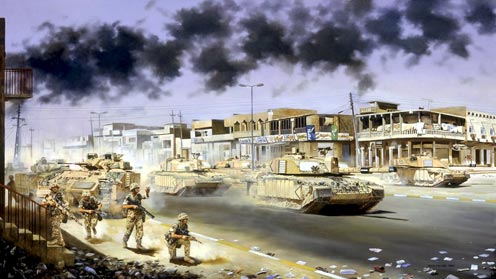
"The Liberation of Basrah"
Ref: DR145
by David Rowlands
Size 58 x 38 cm
6 April 2003: After the port of Umm Qasr was secured by the Royal Marines and US Marines, the main US forces sped north, leaving 1st (UK) Armoured Division to shadow the American forces and deal with the city of Basra. At first, taking the city itself was not part of the plan, but in order to overcome Iraqi military resistance, and provide a secure environment whereby normal life and civil liberty could return as quickly as possible, it became clear that the city would have to fall if the coalition was to achieve its objectives.
1st Armoured Division, commanded by Major General Brims, gradually dominated the terrain around Basra without entering the city. Basra International Airport, west of the city, was seized. The town of Az Zubayr was cleared. Several operations using close air support hit precise targets in Basra.
16 Air Assault Brigade guarded the northern approaches to Basra, while the Royal Marines cleared the southern suburbs. Access to Basra from the west was governed by the bridges over the Shatt al Basra waterway. Bridge Two and Bridge Four were seized, allowing the battlegroups of 7th Armoured Brigade to launch raids of limited duration using Warrriors and Challenger 2s, charging deep into the city, then withdrawing over the secured bridges to the west. Their armour plates were able to resist the plentiful RPGs, mortars and small arms fire from the local militia.
The raids confirmed the growing British dominance of Basra, and early on 6th April the Divisional Commander ordered a three-pronged attack on the city. As darkness fell after a day of fighting, the raiders stayed put, while the enemy attacked them out of the gloom. On 7th April, 3 PARA advanced on foot into the narrow streets of the old town of Basra, which was secured without a shot being fired. Cheering crowds greeted the British, and Basra was taken.
My painting shows Challenger 2 tanks of 2nd Royal Tank Regiment advancing along one of Basra’s dual carriageways. Snipers dismount from a Warrior of 1st Bn The Black Watch, to take up positions on rooftops and balconies. Like the other Platoons in Support Company, they are a Battle Group asset so they are directly tasked by the Battlegroup Commander. Their job is to harass the enemy by taking long-range shots at key targets. In Basra, I sketched Lance Corporal ‘Pedro’ Laing (with the moustache), a Black Watch sniper. He was later awarded the Military Cross for his action in Az Zubayr.
Sanctions against Saddam Hussein’s Iraq meant that ‘Pepsi’ and ‘7 Up’ did not trade there, but that didn’t prevent resourceful shopkeepers from advertising their own products as such!
